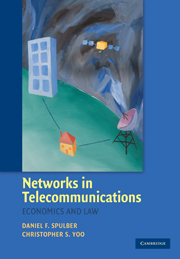Book contents
- Frontmatter
- Contents
- Preface
- Acknowledgments
- Introduction
- PART I THE ECONOMICS OF NETWORKS
- PART II THE REGULATION OF NETWORKS
- 4 Network Regulation Basics
- 5 Economic Effects of Regulating Access to Networks
- 6 Pricing of Access to Networks
- 7 Constitutional Limits on the Pricing of Access to Networks
- PART III POLICY APPLICATIONS
- Conclusion
- Bibliography
- Index
- Table of Cases
7 - Constitutional Limits on the Pricing of Access to Networks
Published online by Cambridge University Press: 05 June 2012
- Frontmatter
- Contents
- Preface
- Acknowledgments
- Introduction
- PART I THE ECONOMICS OF NETWORKS
- PART II THE REGULATION OF NETWORKS
- 4 Network Regulation Basics
- 5 Economic Effects of Regulating Access to Networks
- 6 Pricing of Access to Networks
- 7 Constitutional Limits on the Pricing of Access to Networks
- PART III POLICY APPLICATIONS
- Conclusion
- Bibliography
- Index
- Table of Cases
Summary
The emergence of platform competition and the shift from rate regulation to access regulation compel a different constitutional analysis of regulation. Because rate regulation simply adjusts the terms under which parties can contract, it represents the type of nonpossessory regulation traditionally subjected to a rather permissive standard of review under the Takings Clause. This standard requires only that the rate fall within a zone of reasonableness. Compelling access to a physical network, in contrast, invariably requires the network owner to permit third parties to locate equipment on its property. As such, access regulations are subject to the more restrictive standards associated with the Court's physical takings jurisprudence. Unlike nonpossessory regulations, in which reductions in the value of property are not necessarily compensable, physical takings necessarily command market-value compensation. Principles of constitutional law thus reinforce the basic economic conclusion that network access should be priced at market levels.
The Distinction between Physical and Nonpossessory Takings
The Emergence of the Nonpossessory Takings Doctrine
Initially, the Takings Clause was believed to protect only against direct government appropriations of private property or invasions that effectively divested the owner of possession as though the government formally condemned the property. Government actions that merely reduced property value did not qualify as takings. The Court subsequently recognized two types of takings that can arise without a physical occupation. First, the Court acknowledged that a rate regulation may effect a taking if the rate is set so low as to be confiscatory.
Information
- Type
- Chapter
- Information
- Networks in TelecommunicationsEconomics and Law, pp. 210 - 230Publisher: Cambridge University PressPrint publication year: 2009
